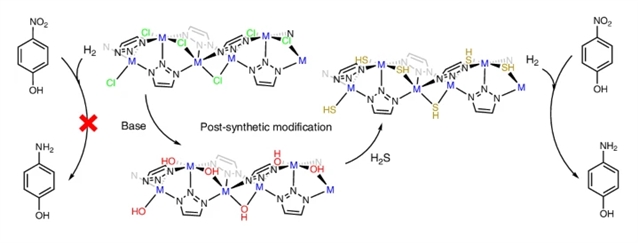
美国西北大学Omar K. Farha团队通过合成后改性在金属有机骨架中引入金属硫活性位点实现加氢催化。2025年7月24日出版的《自然-化学》杂志发表了这项成果。
金属硫活性位点在加氢和脱氢等催化过程中起着核心作用,但这些化合物中的大多数活性位点位于催化剂颗粒的表面和边缘,限制了整体效率。
研究组提出了一种将金属硫活性位点嵌入金属有机框架(MOF)的策略,通过将桥接或末端氯配体转化为氢氧化物,然后通过合成后修饰转化为硫化物基团。该研究团队将这种方法应用于两个具有代表性的MOF家族:一个具有一维金属氯链,另一个包含离散的多核金属。
晶体学和光谱分析证实了结构的完整性和硫化物的掺入,并通过原位全散射方法监测了相变。硫化MOF在硝基芳烃选择性加氢反应中表现出较强的催化活性。密度泛函理论计算表明,硫的加入促进了金属-配体键的均裂,促进了H2的活化。该工作建立了一种构建具有可达金属硫化物位点MOF的方法。
附:英文原文
Title: Introducing metal–sulfur active sites in metal–organic frameworks via post-synthetic modification for hydrogenation catalysis
Author: Xie, Haomiao, Khoshooei, Milad Ahmadi, Mandal, Mukunda, Vornholt, Simon M., Hofmann, Jan, Tufaro, Luke M., Kirlikovali, Kent O., Grimes, Dawson A., Lee, Seryeong, Su, Shengyi, Reischauer, Susanne, Sengupta, Debabrata, Fahy, Kira, Ma, Kaikai, Wang, Xiaoliang, Sha, Fanrui, Gong, Wei, Che, Yongwei, Vitillo, Jenny G., Anderson, John S., Notestein, Justin M., Chapman, Karena W., Gagliardi, Laura, Farha, Omar K.
Issue&Volume: 2025-07-24
Abstract: Metal–sulfur active sites play a central role in catalytic processes such as hydrogenation and dehydrogenation, yet the majority of active sites in these compounds reside on the surfaces and edges of catalyst particles, limiting overall efficiency. Here we present a strategy to embed metal–sulfur active sites into metal–organic frameworks (MOFs) by converting bridging or terminal chloride ligands into hydroxide and subsequently into sulfide groups through post-synthetic modification. We apply this method to two representative MOF families: one featuring one-dimensional metal–chloride chains and another containing discrete multinuclear metal clusters. Crystallographic and spectroscopic analyses confirm structural integrity and sulfide incorporation, and the transformation is monitored by in situ total scattering methods. The sulfided MOFs display enhanced catalytic activity in the selective hydrogenation of nitroarenes using molecular hydrogen. Density functional theory calculations indicate that sulfur incorporation promotes homolytic metal–ligand bond cleavage and facilitates H2 activation. This work establishes an approach to construct MOFs featuring accessible metal–sulfide sites.
DOI: 10.1038/s41557-025-01876-y
Source: https://www.nature.com/articles/s41557-025-01876-y
Nature Chemistry:《自然—化学》,创刊于2009年。隶属于施普林格·自然出版集团,最新IF:24.274
官方网址:https://www.nature.com/nchem/
投稿链接:https://mts-nchem.nature.com/cgi-bin/main.plex
